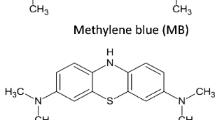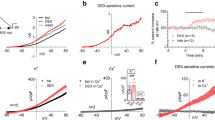Abstract
Dimebon was originally introduced as an antihistamine and subsequently investigated as a possible therapeutic for a variety of disorders, including Alzheimer’s disease. One putative mechanism underlying the neuroprotective properties of Dimebon is inhibition of mitochondrial permeability transition, based on the observation that Dimebon inhibited the swelling of rat liver mitochondria induced by calcium and other agents that induce permeability transition. Because liver and brain mitochondria differ substantially in their properties and response to conditions associated with opening of the permeability transition pore, we sought to determine whether Dimebon inhibited permeability transition in brain mitochondria. Dimebon reduced calcium-induced mitochondrial swelling but did not enhance the calcium retention capacity or impair calcium-induced cytochrome C release from non-synaptic mitochondria isolated from rat brain cerebral cortex. These findings indicate that Dimebon does not inhibit mitochondrial permeability transition, induced by excessive calcium uptake, in brain mitochondria.




Similar content being viewed by others
References
Abdul, H. M., Sultana, R., St Clair, D. K., Markesbery, W. R., & Butterfield, D. A. (2008). Oxidative damage in brain from human mutant APP/PS-1 double knock-in mice as a function of age. Free Radical Biology and Medicine, 45, 1420–1425.
Bachurin, S., Bukatina, E., Lermontova, N., Tkachenko, S., Afanasiev, A., Grigoriev, V., et al. (2001). Antihistamine agent Dimebon as a novel neuroprotector and a cognition enhancer. Annals of the New York Academy of Sciences, 939, 425–435.
Bachurin, S. O., Shevtsova, E. P., Kireeva, E. G., Oxenkrug, G. F., & Sablin, S. O. (2003). Mitochondria as a target for neurotoxins and neuroprotective agents. Annals of the New York Academy of Sciences, 993, 334–344. discussion 345–339.
Berman, S. B., Watkins, S. C., & Hastings, T. G. (2000). Quantitative biochemical and ultrastructural comparison of mitochondrial permeability transition in isolated brain and liver mitochondria: Evidence for reduced sensitivity of brain mitochondria. Experimental Neurology, 164, 415–425.
Bernardi, P., Krauskopf, A., Basso, E., Petronilli, V., Blachly-Dyson, E., Di Lisa, F., et al. (2006). The mitochondrial permeability transition from in vitro artifact to disease target. The FEBS Journal, 273, 2077–2099.
Brown, M. R., Sullivan, P. G., & Geddes, J. W. (2006). Synaptic mitochondria are more susceptible to Ca2 + overload than nonsynaptic mitochondria. The Journal of Biological Chemistry, 281, 11658–11668.
Brustovetsky, N., Brustovetsky, T., Jemmerson, R., & Dubinsky, J. M. (2002). Calcium-induced cytochrome c release from CNS mitochondria is associated with the permeability transition and rupture of the outer membrane. Journal of Neurochemistry, 80, 207–218.
Doody, R. S., Gavrilova, S. I., Sano, M., Thomas, R. G., Aisen, P. S., Bachurin, S. O., et al. (2008). Effect of dimebon on cognition, activities of daily living, behaviour, and global function in patients with mild-to-moderate Alzheimer’s disease: A randomised, double-blind, placebo-controlled study. Lancet, 372, 207–215.
Du, H., Guo, L., Zhang, W., Rydzewska, M. and Yan, S. (2009). Cyclophilin D deficiency improves mitochondrial function and learning/memory in aging Alzheimer disease mouse model. Neurobiology of Aging. doi:10.1016/j.neurobiolaging.2009.03.003.
Galenko-Iaroshevskii, P. A., Chekanova, O. A., Skibitskii, V. V., Bartashevich, V. V., Khankoeva, A. I., & Poliashova, T. I. (1995). Antiarrhythmic properties of dimebone. Biulleten’ eksperimental’noĭ biologii i meditsiny, 119, 375–377.
Galenko-Iaroshevskii, P. A., Sheikh-Zade Iu, R., Chekanova, O. A., Melkumova, E. R., Bartashevich, V. V., & Khankoeva, A. I. (1996). Effect of dimebone on coronary blood flow and myocardial contractibility. Biulleten’ eksperimental’noĭ biologii i meditsiny, 121, 506–508.
Grigorev, V. V., Dranyi, O. A., & Bachurin, S. O. (2003). Comparative study of action mechanisms of dimebon and memantine on AMPA- and NMDA-subtypes glutamate receptors in rat cerebral neurons. Bulletin of Experimental Biology and Medicine, 136, 474–477.
Hansson, M. J., Persson, T., Friberg, H., Keep, M. F., Rees, A., Wieloch, T., et al. (2003). Powerful cyclosporin inhibition of calcium-induced permeability transition in brain mitochondria. Brain Research, 960, 99–111.
Haworth, R. A., & Hunter, D. R. (1979). The Ca2+-induced membrane transition in mitochondria. II. Nature of the Ca2+ trigger site. Archives of Biochemistry and Biophysics, 195, 460–467.
Jicha, G. A., & Markesbery, W. R. (2010). Omega-3 fatty acids: Potential role in the management of early Alzheimer’s disease. Clinical Interventions in Aging, 5, 45–61.
Jo, D. G., Arumugam, T. V., Woo, H. N., Park, J. S., Tang, S. C., Mughal, M., et al. (2010). Evidence that gamma-secretase mediates oxidative stress-induced beta-secretase expression in Alzheimer’s disease. Neurobiology of Aging, 31, 917–925.
Kobayashi, T., Kuroda, S., Tada, M., Houkin, K., Iwasaki, Y., & Abe, H. (2003). Calcium-induced mitochondrial swelling and cytochrome c release in the brain: Its biochemical characteristics and implication in ischemic neuronal injury. Brain Research, 960, 62–70.
Kristian, T., Gertsch, J., Bates, T. E., & Siesjo, B. K. (2000). Characteristics of the calcium-triggered mitochondrial permeability transition in nonsynaptic brain mitochondria: Effect of cyclosporin A and ubiquinone O. Journal of Neurochemistry, 74, 1999–2009.
Lermontova, N. N., Lukoyanov, N. V., Serkova, T. P., Lukoyanova, E. A., & Bachurin, S. O. (2000). Dimebon improves learning in animals with experimental Alzheimer’s disease. Bulletin of Experimental Biology and Medicine, 129, 544–546.
Lermontova, N. N., Redkozubov, A. E., Shevtsova, E. F., Serkova, T. P., Kireeva, E. G., & Bachurin, S. O. (2001). Dimebon and tacrine inhibit neurotoxic action of beta-amyloid in culture and block L-type Ca(2+) channels. Bulletin of Experimental Biology and Medicine, 132, 1079–1083.
Lovell, M. A., Xiong, S., Lyubartseva, G., & Markesbery, W. R. (2009). Organoselenium (Sel-Plex diet) decreases amyloid burden and RNA and DNA oxidative damage in APP/PS1 mice. Free Radical Biology and Medicine, 46, 1527–1533.
Markesbery, W. R. (1997). Oxidative stress hypothesis in Alzheimer’s disease. Free Radical Biology and Medicine, 23, 134–147.
Markesbery, W. R., Ehmann, W. D., Hossain, T. I., Alauddin, M., & Goodin, D. T. (1981). Instrumental neutron activation analysis of brain aluminum in Alzheimer disease and aging. Annals of Neurology, 10, 511–516.
Mateeva, I. A. (1983). Action of Dimebon on histamine receptors. Farmakologiia i toksikologiia (Russ.), 46, 27–29.
Miller, G. (2010). Pharmacology. The puzzling rise and fall of a dark-horse Alzheimer’s drug. Science, 327, 1309.
Morota, S., Mansson, R., Hansson, M. J., Kasuya, K., Shimazu, M., Hasegawa, E., et al. (2009). Evaluation of putative inhibitors of mitochondrial permeability transition for brain disorders–specificity vs. toxicity. Experimental Neurology, 218, 353–362.
Naga, K. K., Sullivan, P. G., & Geddes, J. W. (2007). High cyclophilin D content of synaptic mitochondria results in increased vulnerability to permeability transition. Journal of Neuroscience, 27, 7469–7475.
Reddy, P. H. (2009). Amyloid beta, mitochondrial structural and functional dynamics in Alzheimer’s disease. Experimental Neurology, 218, 286–292.
Shadurskaia, S. K., Khomenko, A. I., Pereverzev, V. A., & Balaklevskii, A. I. (1986). Neuromediator mechanisms of the effect of the antihistamine agent dimebone on the brain. Biulleten’ eksperimental’noĭ biologii i meditsiny, 101, 700–702.
Shadurskii, K. S., Matveeva, I. A., & Il’iuchenok, T. (1983). Therapeutic and protective properties of dimebon in burns. Farmakologiia i toksikologiia, 46, 90–92.
Sonnen, J. A., Breitner, J. C., Lovell, M. A., Markesbery, W. R., Quinn, J. F., & Montine, T. J. (2008). Free radical-mediated damage to brain in Alzheimer’s disease and its transgenic mouse models. Free Radical Biology and Medicine, 45, 219–230.
Wu, J., Li, Q., & Bezprozvanny, I. (2008). Evaluation of Dimebon in cellular model of Huntington’s disease. Molecular Neurodegeneration, 3, 15.
Zoratti, M., & Szabo, I. (1995). The mitochondrial permeability transition. Biochimica et Biophysica Acta, 1241, 139–176.
Acknowledgments
This research was supported by NIH grants PO1NS058484, PO1AG010836, R01NS062993, and P30NS051220, as well as funding from the Kentucky Spinal Cord and Head Injury Research Trust.
Author information
Authors and Affiliations
Corresponding author
Rights and permissions
About this article
Cite this article
Naga, K.K., Geddes, J.W. Dimebon Inhibits Calcium-Induced Swelling of Rat Brain Mitochondria But Does Not Alter Calcium Retention or Cytochrome C Release. Neuromol Med 13, 31–36 (2011). https://doi.org/10.1007/s12017-010-8130-x
Received:
Accepted:
Published:
Issue Date:
DOI: https://doi.org/10.1007/s12017-010-8130-x




